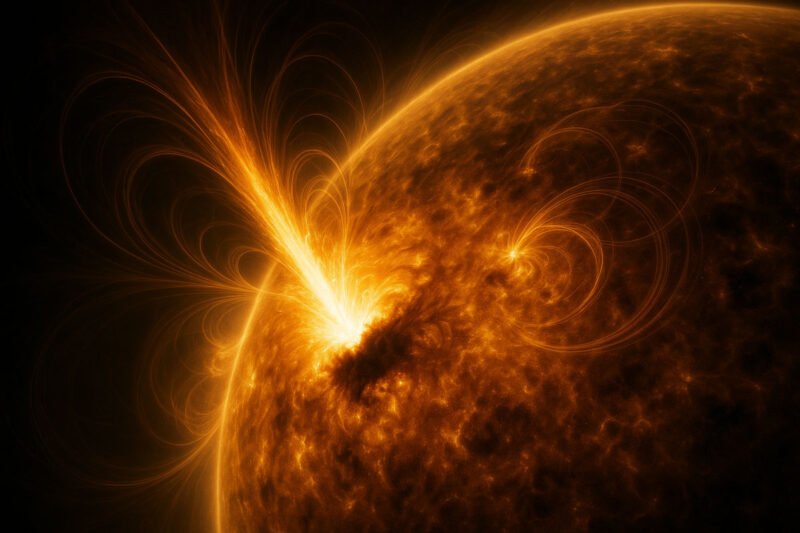Introduction to AR4087: A Solar Powerhouse
When astronomers first spotted AR4087 rotating into view on the Sun’s northeastern limb in early May 2025, few could have predicted the chaos this seemingly ordinary sunspot region would unleash. Within days, this volatile solar phenomenon had triggered the strongest flares of the year, plunging entire continents into radio silence and reminding us just how connected we are to our nearest star’s temperamental behavior.
What makes AR4087 particularly fascinating isn’t just its raw power—it’s the sheer unpredictability of its outbursts. Unlike some sunspot regions that follow more predictable patterns, AR4087’s volatility has kept space weather forecasters on edge. The region’s magnetic complexity creates conditions where massive energy releases can happen with little warning, turning routine space weather monitoring into a high-stakes game of cosmic roulette.
The significance of AR4087 extends beyond academic interest. Its explosive outbursts have demonstrated the vulnerability of our increasingly connected world to space weather events. As this sunspot region continues its rotation across the solar disk, scientists maintain vigilant monitoring to predict its next volatile episode.
The Science Behind Solar Volatility
Think of solar volatility as the Sun’s version of a pressure cooker reaching its breaking point. Deep beneath the Sun’s surface, churning plasma creates magnetic fields that twist and tangle like invisible rubber bands under extreme tension. When these magnetic field lines finally snap—which can happen without warning—they release energy equivalent to billions of hydrogen bombs exploding simultaneously.
The classification system scientists use to measure these cosmic tantrums reads like a scale of natural disasters. Starting with gentle A-class flares that barely register on instruments, the scale climbs through B, C, and M classes before reaching the monster X-class events. Each step up represents ten times more energy than the previous level. To put this in perspective, the X2.7 flare from AR4087 packed roughly 27 times more punch than an X1 flare—enough energy to power the entire United States for several years.
AR4087’s Volatile Behavior Patterns
May 14, 2025, started like any other day for space weather watchers—until AR4087 decided to throw a cosmic tantrum that would make headlines worldwide. The trouble began at 03:25 UTC with what seemed like a relatively modest M5.3 flare. Space weather forecasters noted the event but weren’t particularly alarmed. After all, M-class flares happen fairly regularly during solar maximum periods.
But AR4087 was just getting warmed up. Five hours later, at 08:25 UTC, the sunspot region unleashed its fury with an X2.7 flare that lit up monitoring stations across the globe. The timing couldn’t have been worse—or better, depending on your perspective. The flare struck during peak daylight hours across Europe and Asia, maximizing its impact on radio communications while providing scientists with unprecedented data on how these events unfold in real-time.
The volatility didn’t stop there. As if to prove that lightning can indeed strike twice in the same place, AR4087 followed up with an M7.7 flare just hours later. This rapid-fire sequence left space weather experts scrambling to update their forecasts and wondering what this unpredictable region might do next.
Real-World Impact of AR4087’s Volatility
When AR4087’s X2.7 flare hit Earth’s atmosphere, the effects were immediate and far-reaching. Imagine trying to make a phone call and hearing nothing but static, or attempting to tune into your favorite radio station only to find dead air. That’s exactly what happened across vast swaths of the planet as high-frequency radio waves—the backbone of long-distance communication—simply vanished into the ionospheric chaos.
The blackout zone stretched from London to Tokyo, encompassing roughly half the planet’s daylight side. Air traffic controllers in major European hubs found themselves temporarily cut off from aircraft crossing the Atlantic. Ships navigating busy shipping lanes in the Mediterranean and South China Sea lost their primary means of long-range communication. Even amateur radio operators, typically resilient to space weather disruptions, reported complete signal loss across multiple frequency bands.
What made this event particularly noteworthy wasn’t just its geographic scope, but its timing. The flare struck during peak business hours across Europe and Asia, affecting millions of people who depend on reliable communications for everything from emergency services to international commerce. The economic ripple effects, while difficult to quantify precisely, likely reached into the millions of dollars in lost productivity and delayed operations.
Measuring and Predicting Solar Volatility
The challenge of measuring and predicting solar volatility requires sophisticated monitoring systems and advanced forecasting techniques. NOAA’s Space Weather Prediction Center employs a comprehensive approach to track and analyze solar activity, using data from multiple satellites and ground-based observatories.
Current forecasting methods rely on analyzing the magnetic complexity of active regions like AR4087. Scientists examine the configuration and strength of magnetic fields within sunspot regions to assess their potential for volatile behavior. However, the inherently chaotic nature of solar dynamics makes precise predictions extremely challenging.
Following AR4087’s initial outbursts, space weather forecasters issued probability-based predictions indicating a 65% chance of M-class flare activity and a 30% chance of X-class events through May 17, 2025. These probabilistic forecasts reflect the uncertainty inherent in predicting volatile solar phenomena while providing valuable guidance for affected industries.
The Magnetic Complexity Factor
The volatile behavior exhibited by AR4087 stems largely from its magnetic complexity, a characteristic that distinguishes highly active sunspot regions from their more stable counterparts. Magnetic complexity refers to the intricate arrangement and interaction of magnetic field lines within an active region.
When magnetic field lines become highly twisted and intertwined, they create conditions ripe for sudden and violent realignment. This process, known as magnetic reconnection, releases enormous amounts of stored magnetic energy in the form of solar flares and coronal mass ejections. The more complex the magnetic configuration, the greater the potential for volatile eruptions.
AR4087’s magnetic complexity made it particularly unpredictable, with scientists noting that such configurations often lead to sustained periods of heightened activity. The region’s ability to produce multiple powerful flares in rapid succession demonstrated how magnetic complexity translates directly into volatile solar behavior.
Future Implications and Preparedness
The volatile behavior of AR4087 serves as a stark reminder of our civilization’s vulnerability to space weather events. As the sunspot region continues its rotation toward a more Earth-facing position, the potential for future disruptions remains significant.
Infrastructure protection strategies must evolve to address the growing threat posed by volatile solar regions. Power grid operators, satellite companies, and communication providers are implementing enhanced monitoring and protective measures to mitigate the impact of future space weather events.
The lessons learned from AR4087’s volatile outbursts will inform future space weather preparedness efforts. Scientists continue to refine their understanding of solar volatility patterns, working to improve prediction capabilities and develop more effective protection strategies for critical infrastructure.
Conclusion: Living with Solar Volatility
AR4087’s remarkable display of solar volatility has provided valuable insights into the unpredictable nature of our nearest star. The region’s explosive behavior serves as both a scientific opportunity and a practical challenge, highlighting the need for continued vigilance in space weather monitoring.
The significance of AR4087 extends beyond its immediate impact on Earth’s communication systems. It represents a window into the complex dynamics of solar activity and the ongoing challenge of predicting volatile space weather events. As our technological dependence continues to grow, understanding and preparing for solar volatility becomes increasingly critical.
Future research into solar volatility will undoubtedly benefit from the detailed observations of AR4087’s behavior. The region’s legacy will contribute to improved forecasting capabilities and better protection strategies, helping humanity adapt to the volatile nature of our solar environment.









